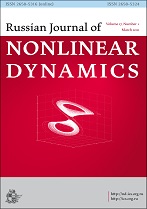|
This article is cited in 1 scientific paper (total in 1 paper)
Nonlinear engineering and robotics
Analysis and Simulation of BER Performance of Chaotic Underwater Wireless Optical Communication Systems
I. V. Semernik, O. V. Bender, A. A. Tarasenko, Ch. V. Samonova
JSC Yuzhmorgeologia
ul. Krymskaya 20, Gelendzhik, 353461 Russia
Abstract:
In this article, a method for increasing the noise immunity of an underwater wireless optical communication system by applying chaotic oscillations is considered. To solve this problem, it is proposed to use modulation methods based on dynamical chaos at the physical level of the communication channel.
Communication channel modeling is implemented by calculating the impulse response using a numerical solution of the radiation transfer equation by the Monte Carlo method. The following modulation methods based on the correlation processing of the received signal are considered: chaotic mode switching, chaotic on-off keying (COOK). On-off keying (OOK) modulation was chosen as a test modulation method to assess the degree of noise immunity of the modulation methods under study.
An analysis of the noise immunity of an underwater optical communication channel with a change in its length and parameters of the aquatic environment, which affect the absorption and scattering of optical radiation in the communication channel, is carried out.
It is shown that modulation methods based on the phenomenon of dynamic chaos and correlation processing can improve the noise immunity of underwater wireless communication systems. This provides the possibility of signal recovery at negative values of the signal-to-noise ratio. It is shown that the considered modulation methods (COOK and switching of chaotic modes) in combination with the correlation processing of the signal at the physical level of the communication channel provide an advantage of about 15 dB compared to OOK modulation.
Keywords:
underwater communication, optical communication, wireless communication, dynamical chaos, noise immunity, wideband signals, communication channel modeling, modulation, Monte Carlo method.
Received: 10.08.2022
Accepted: 15.11.2022
Citation:
I. V. Semernik, O. V. Bender, A. A. Tarasenko, Ch. V. Samonova, “Analysis and Simulation of BER Performance of Chaotic Underwater Wireless Optical Communication Systems”, Rus. J. Nonlin. Dyn., 19:1 (2023), 137–158
Linking options:
https://www.mathnet.ru/eng/nd843 https://www.mathnet.ru/eng/nd/v19/i1/p137
|

| Statistics & downloads: |
| Abstract page: | 158 | | Full-text PDF : | 94 | | References: | 36 |
|




 Contact us:
Contact us: Terms of Use
Terms of Use
 Registration to the website
Registration to the website Logotypes
Logotypes








 Citation in format
Citation in format 
